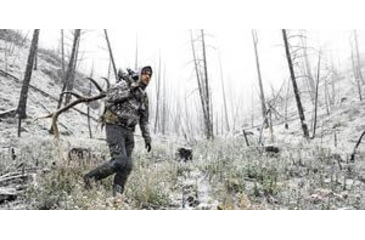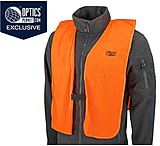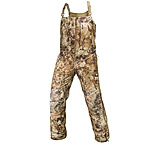There is a science behind hunting camo patterns that manufacturers use to create the best camouflage for different scenarios. While some flock to the flashiest hunting clothes out there, you will greatly increase your success in the field if you take the time to choose the best hunting camouflage based on the type of game you're hunting, how you're hunting it, and where you're hunting. In this guide, we'll discuss how waterfowl, deer, and other big game see colors and patterns to help you pick out the perfect set.![]()
Can Deer See Orange?
The pressing question on a lot of hunters' minds is if deer can see their blaze orange vests. Wearing bright orange hunting clothes helps nearby hunters easily spot you, and you should never skimp on safety in hopes of improving your hunting success. Not only because it's dangerous, but deer cannot even see your bright orange clothes as humans can.
What Colors Can Deer See?
While deer see colors differently, that does not mean they only see in black and white. Instead, deer have dichromatic vision, which means they are basically red-green color blind. Whitetails cannot distinguish red, orange, and green from one another, so when you wear blaze orange, they cannot tell the difference in color between your vest, tree bark, grass, and other natural elements.
How Humans See Hunters How Deer See Hunters
Contrary to human eyesight, deer lack UV filters, which accentuates their night vision capabilities. This usually wouldn't be an issue for hunters, but most laundry detergents on your local shelves contain optical brighteners, which are chemicals used to make your clothes look bright and brand spanking new. To deer, such UV-enhancing chemicals will make you glow and be easily spotted by bucks. While you can hope that deer think you're an angel and flock to your presence, this has not been the case for me or anyone I know thus far.
So what does this mean to you as a hunter?
- Wearing blaze orange does not impact how deer see you.
- Deer can see the color blue well, so avoid wearing anything blue while hunting.
- Use laundry detergents without optical brighteners to avoid being seen.
- If you're unsure, use a blacklight to check your camo for brighteners.
And that's it. Just don't wear blue and be mindful of what laundry detergent you use. However, this is just to help you choose a camo color for your hunt. The type of hunting camo pattern you choose matters much more, which brings us to our next section.
What Does Camouflage Look Like to Deer?
Before we explain how to pick the best deer hunting camo, it's important to understand how camouflage works. There are two main types of hunting camouflage: mimicry and breakup (digital).
Mimicry Hunting Camo
- As the name suggests, mimicry camo mimics your surroundings to help you visually blend in with the environment.
- Mimicry camo patterns feature leaves, sticks, tree bark, and other elements of nature.
Breakup Hunting Camo
- On the other hand, breakup, or digital, camouflage breaks apart your outline to help you stay invisible to prey.
- Breakup camo patterns use abstract shapes and color schemes to keep you concealed.
While whitetails struggle to differentiate color, they are remarkably efficient at spotting movement. This means that the best deer hunting camo is one that conceals your movements the most, which would fall under the breakup camo category. Digital camouflage breaks apart your outline against the background so that deer do not see a solid human outline in the trees. If you move, deer will visually register your camouflage as individual, and hopefully non-threatening, parts. They're used to seeing harmless birds and leaves blow by, so your movements are perceived as significantly less threatening than if they saw your entire silhouette moving.
What Hunting Camo Is Best for Other Big Game?
To be frank, all of the information above applies to hunting elk and other large game animals, as they have similar eyesight. That being said, there are a couple of considerations to take in with different types of hunting. For example, bowhunters need to be much closer to their prey than those who hunt with rifles. The closer you get to your prey, the more they can smell you, and these animals have a superior sense of smell. While this may not impact your hunting camo choice, you will want to mask your scent. ScentLok and other manufacturers design hunting clothes with built-in odor control (and are available in many types of camo), or you can go with traditional scent blockers.
For treestand hunters, you need to be mindful of your elevated location. The best hunting camouflage on the ground may not always be the same in a treestand since you're up in the tree line with branches and the sky present. Become familiar with the area you're hunting in to choose the best camo possible. For example, you may want woodland camo pants but a lighter hunting jacket that matches the skyline for maximum stealth.
How Do Birds and Waterfowl See Hunting Camo?
While most game animals lack powerful eyesight, our feathered friends are a completely different story. The phrase "bird's eye view" certainly goes beyond an elevated glimpse of the world. Their vision is superior to ours, which means that breakup camo is not much use unless you're in a hunting blind. You'll need mimicry camo that resembles the environment you're hunting in, so it is important to know the area beforehand. Birds can see color extremely well, so your hunting outfit needs to resemble the environment's color scheme and natural patterns. Marsh or light woodland camo patterns should get the job done.
A bird's vision does have something in common with deer -- they also lack a UV filter.
- This means that any shiny, reflective surface on you can give away your position and scare away the flock.
- That includes your skin!
- Hunting face nets help eliminate this problem.
- You also need to make sure your firearm and scope have matte finishes that reduce reflectivity.
Set Your Sights on Success
Different animals see the world in unique ways and understanding how their vision works is the key to picking out the best hunting camo for the job. Deer cannot see orange, so always wear your blaze orange vest or clothing for safety purposes. It won't impact your chances of success in the field. Also, don't forget that blue is the main color to avoid with game animals, and breakup camouflage patterns are the best choice for deer hunting.
Both deer and birds lack UV filters, so removing any reflectivity from yourself and gear is critical to avoid being spotted. Opt for mimicry camo patterns for turkey, waterfowl, and birds since they see as humans do -- only much, much better.
Hopefully, this guide helped you understand how animals see the world around us and will lead you to the best choice of camouflage for your next hunt. If you want to learn more about picking out the perfect hunting outfit, check out our guide all about Choosing the Best Hunting Clothes.






